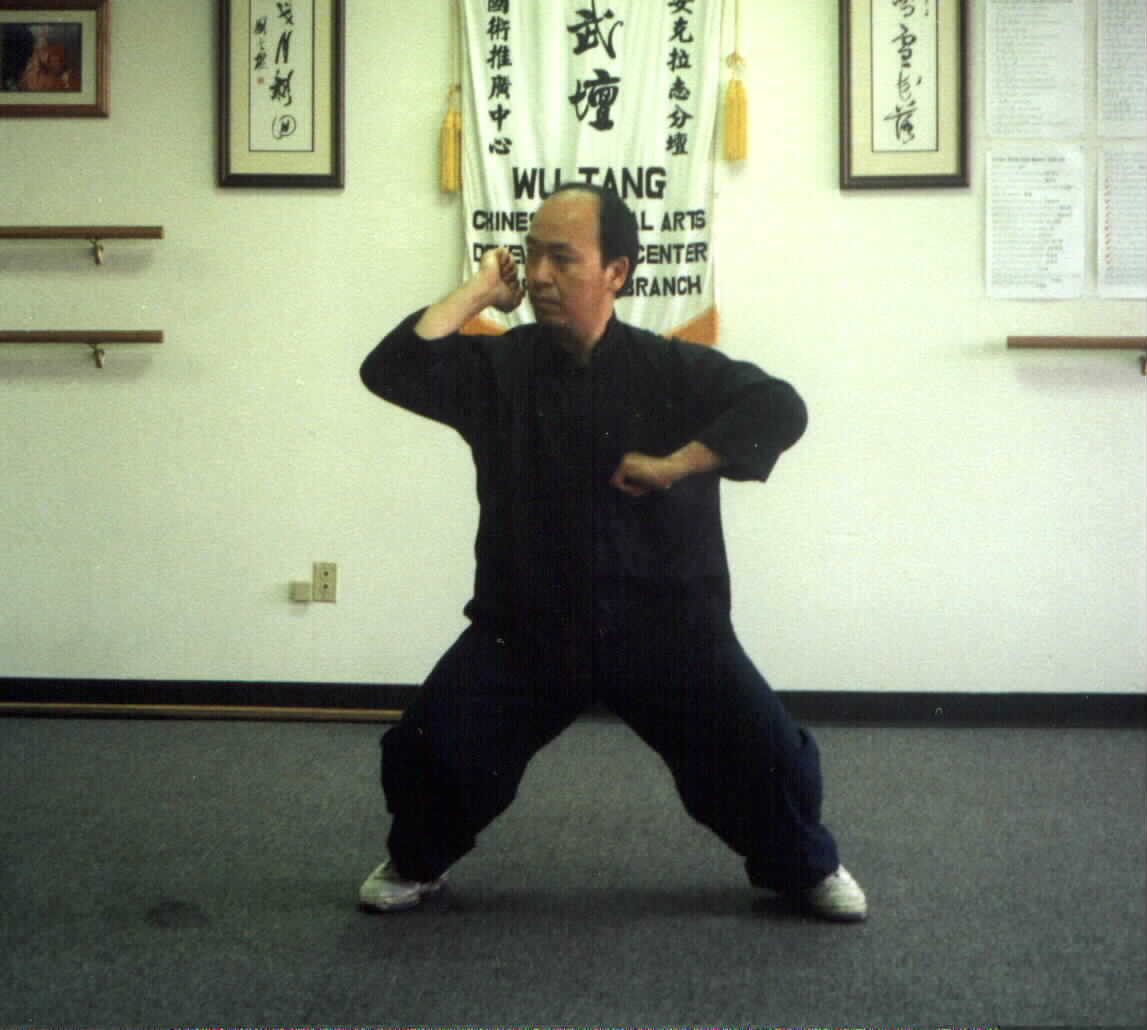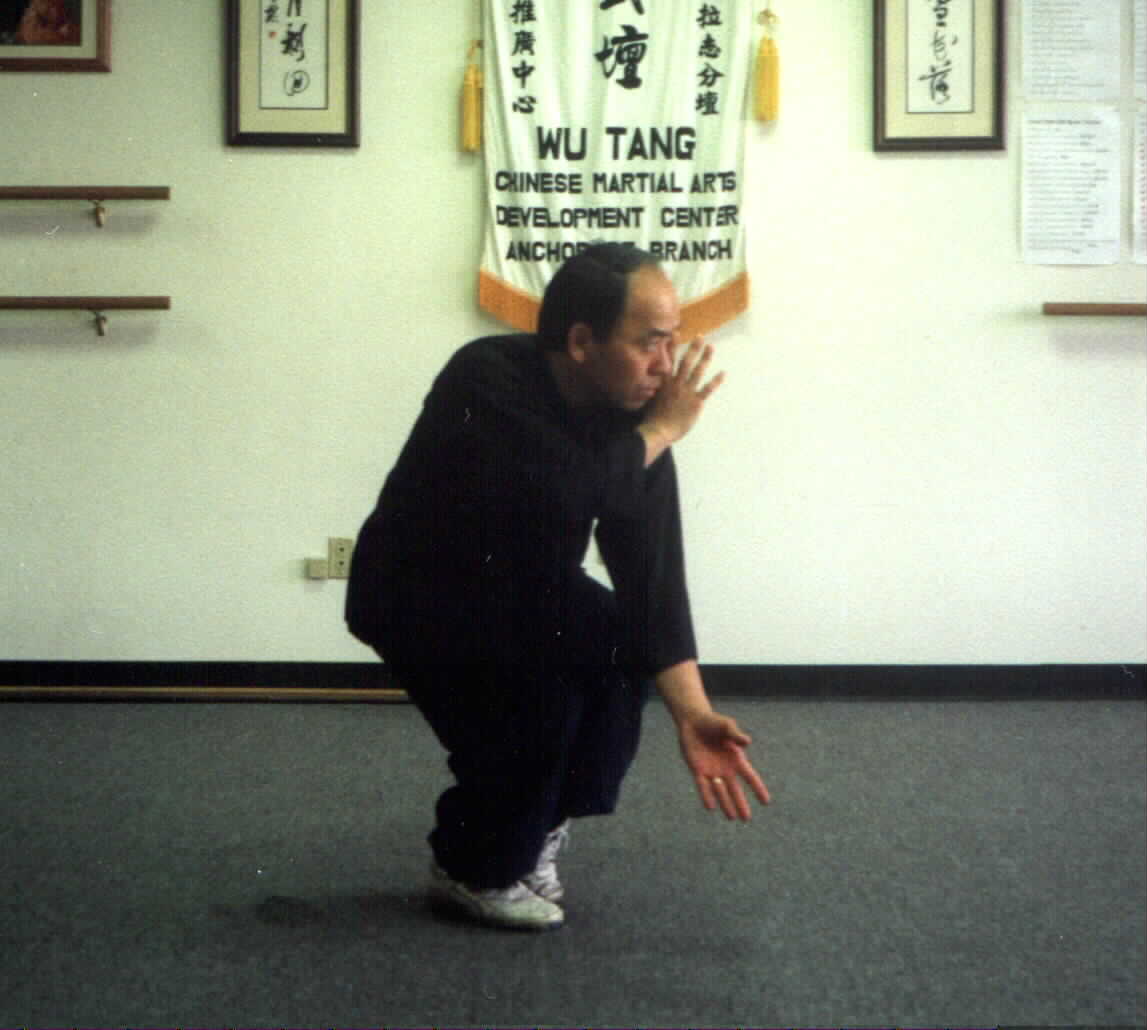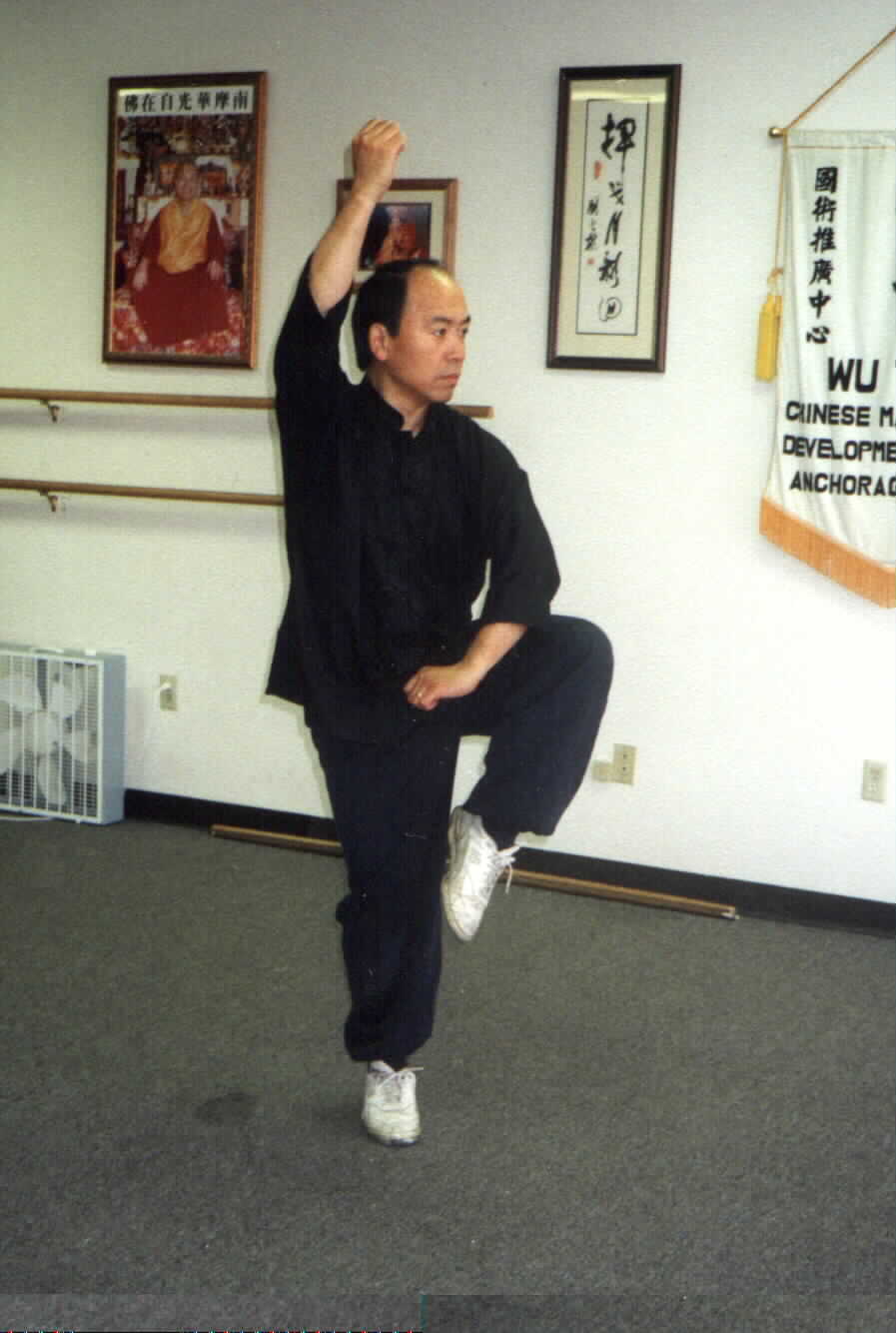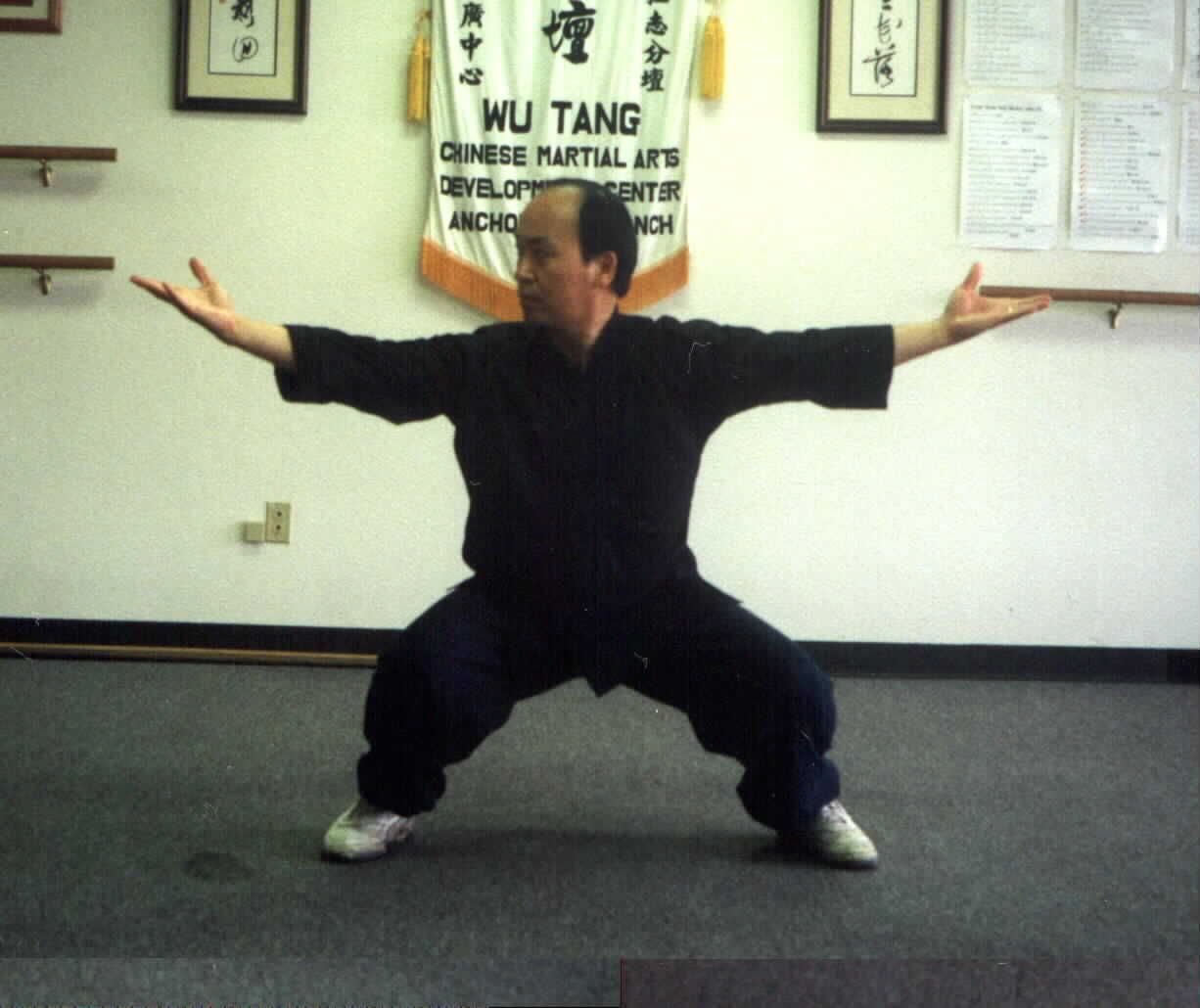

The trademark of the Wu-Tan Kuo Shu Lineage is the Bajiquan style. Bajiquan, or the Eight Infinite Fist-style, is a very ruthless and direct style, which teaches a person to defeat an attacker with one single technique. The training is quite harsh; students spend a long period of time maintaining low stances to develop its notorious internal power (jing). One of the main features of this style is its loud stomps, which punctuates its discharging of energy. It is a close range style that uses all eight locations of the body (head, shoulders, elbows, hands, feet, buttocks, hips, and knees) to deliver cruel and painful strikes.
Bajiquan is taught along with Piquazhang or the Splitting Deflecting Palm
Style. Piquazhang is a style which teaches primarily palm strikes. The jings taught
in Piqua are long and continuous. Its movements are wide and circular, which is the total
opposite of Bajiquan. The two styles compliment each other if put together: Baji is a
hard, linear, and close quarters style, whereas Piqua is a soft, circular, and long-range
style. Both hard and soft is needed in order to be balanced, just like the Daoist theory
of opposites, the Yin and Yang. They are only taught to indoor disciples of the Wu-Tan
lineage.
palm strikes. The jings taught
in Piqua are long and continuous. Its movements are wide and circular, which is the total
opposite of Bajiquan. The two styles compliment each other if put together: Baji is a
hard, linear, and close quarters style, whereas Piqua is a soft, circular, and long-range
style. Both hard and soft is needed in order to be balanced, just like the Daoist theory
of opposites, the Yin and Yang. They are only taught to indoor disciples of the Wu-Tan
lineage.
Although Bajiquan is said to have been created during the mid Ming Dynasty, not much is known about it’s origins or founder. The original name of the style was Baziquan, Rake fist, because the fist was similar to a rake. Since the name was considered to be "ugly," it was changed to Bajiquan. The only person that can be directly linked to Bajiquan is a man named Wu Zhong, a Chinese Muslim from Cang County, Hebei Province. Wu Zhong lived during the Qing dynasty, a time where the foreign Manchus ruled all of China. There is a story that tells of two wondering Daoist monks by the name of Lai and Pi who taught Bajiquan and Piquazhang to Wu. According to Sifu James Guo’s homepage, the two Daoist monks could have been Ming rebels in disguise to hide their true identity from the Qing. Wu Zhong himself was also a Ming rebel who wanted to over-through the Qing government and taught many people from his family and townspeople. Wu Zhong was eventually found out by the Qing and paid with his life. Bajiquan and Piquazhang were taught together as one style during the time of Wu Zhong.
It was not until the time of Wu Rong, Wu Zhong’s daughter, the style split into two separate systems. Since Wu Rong was a woman, Piquazhang’s soft movements were more useful to her than Bajiquan’s forceful movements. This could be the reason why after Wu Zhong’s death, she only taught Piquazhang to her students in the Luo Tong village. However, in the home village of Wu Zhong, Mong Village, the Baji style was only taught. The two styles were taught separately until the coming of Great Grandmaster Li Shu Wen (1864-1934) of the Zhang Sha village, Cang County. Li Shu Wen was taught Bajiquan by Jin Dai Sheng of the Mong Village and Piquazhang by Huang Si Hai of the Luo Tong Village. Li Shu Wen then reunited the two styles.
 It is said the GM Li never knew the feeling of
a second punch since the first punch would kill his opponents. GM Li never saw defeat and
accepted many challenges. There is a story of GM Li and a famous Six-Harmony Mantis master
who was offended by GM Li’s remark about the his style. GM Li remarked that the
master’s style took to much time and was useless in a fight. Angered by GM Li’s
remark, he challenged GM Li to a fight. Before the master threw the first strike, GM Li
immediately punched the master and killed him instantly. Next to GM Li Shu Wen’s Baji
and Piqua styles, he was also known for his spear fighting skills. GM Li Shu Wen was given
the name of "God of Spear" for his prowess in spear fighting. Unfortunately, GM
Li had many jealous enemies and was later poisoned. There were many
well-accomplished martial artists who sought out GM Li to teach them the Baji and Piqua
styles. Among GM Li’s students, there are three who taught Bajiquan to China’s
most influential leaders’ bodyguards. The first was Huo Dian Ge, who was the last
emperor Pu Yi’s bodyguard. Huo also taught Bajiquan to the emperor and his personal
guards. The second was Li Chen Wu, who taught the secret police of Chairman Mao Tse Tung.
The final and last closed-door disciple of GM Li was Liu Yun Chiao, who taught the
presidential guards of Chang Kai Chek, and later taught Sifu Kurt Wong. This is why
Bajiquan and Piquazhang are considered to be the "Bodyguard Styles."
It is said the GM Li never knew the feeling of
a second punch since the first punch would kill his opponents. GM Li never saw defeat and
accepted many challenges. There is a story of GM Li and a famous Six-Harmony Mantis master
who was offended by GM Li’s remark about the his style. GM Li remarked that the
master’s style took to much time and was useless in a fight. Angered by GM Li’s
remark, he challenged GM Li to a fight. Before the master threw the first strike, GM Li
immediately punched the master and killed him instantly. Next to GM Li Shu Wen’s Baji
and Piqua styles, he was also known for his spear fighting skills. GM Li Shu Wen was given
the name of "God of Spear" for his prowess in spear fighting. Unfortunately, GM
Li had many jealous enemies and was later poisoned. There were many
well-accomplished martial artists who sought out GM Li to teach them the Baji and Piqua
styles. Among GM Li’s students, there are three who taught Bajiquan to China’s
most influential leaders’ bodyguards. The first was Huo Dian Ge, who was the last
emperor Pu Yi’s bodyguard. Huo also taught Bajiquan to the emperor and his personal
guards. The second was Li Chen Wu, who taught the secret police of Chairman Mao Tse Tung.
The final and last closed-door disciple of GM Li was Liu Yun Chiao, who taught the
presidential guards of Chang Kai Chek, and later taught Sifu Kurt Wong. This is why
Bajiquan and Piquazhang are considered to be the "Bodyguard Styles."
To illustrate the effectiveness of Bajiquan and Piquazhang, there is a famous saying in China: "When Piqua is added to Baji, demons and spirits will be terrified" and "When the Baji is added to the Piqua, heroes will sigh knowing they are no match against it."
